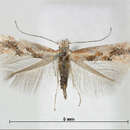en
names in breadcrumbs


Phyllonorycter cytisifoliae is a moth of the family Gracillariidae.[1][2] It is endemic to the Canary Islands and is known from Gran Canaria, La Palma, and Tenerife.[2]
The larvae feed on Chamaecytisus palmensis[2] and Chamaecytisus proliferus.[2][3] They mine the leaves of their host plant. They create a small, upper-surface, tentifom mine. The mine is only a little folded and hardly contacts the leaflet. Pupation takes place inside the mine.[3]
Phyllonorycter cytisifoliae is a moth of the family Gracillariidae. It is endemic to the Canary Islands and is known from Gran Canaria, La Palma, and Tenerife.